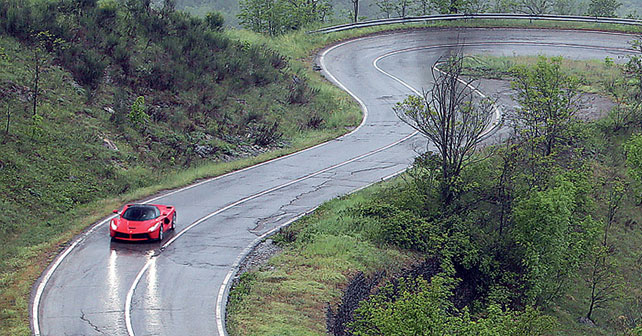


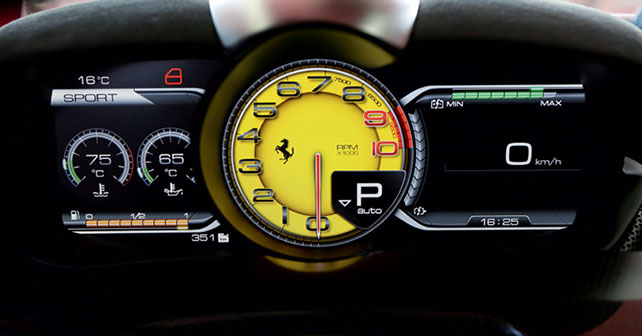
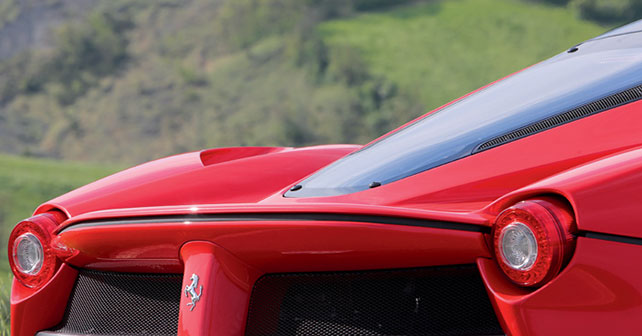
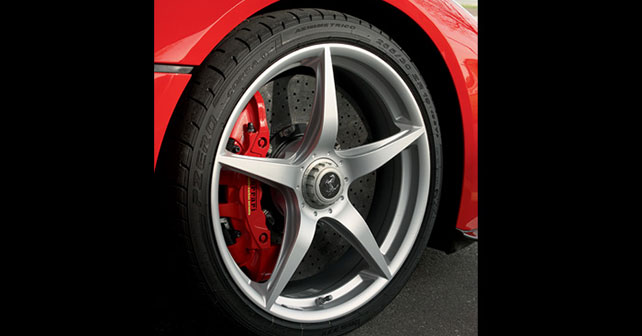

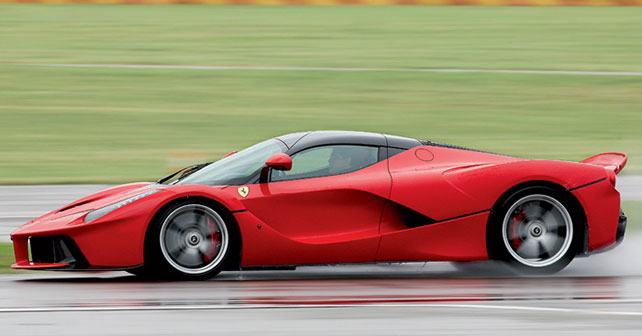
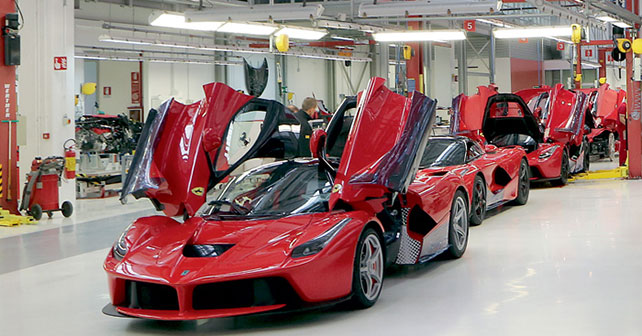
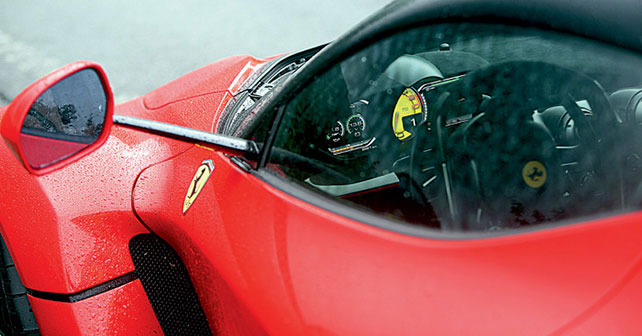
Powered by a meaty V12, the Ferrari Laferrari is a supercar that puts every other supercar in a measly position. So, can we tame this Ferrari in our quick drive in Maranello? Well. let's hope we do.
The roaring soundtrack of a V12 accompanies the red flash that rolls up and down the hills in the pouring rain. It’s the latest expression of speed by the prancing horse – pushing automotive technology to levels never seen before…
A video has been receiving thousands of clicks off late – it shows Kimi Raikkonen, the quite effusive Formula 1 driver, driving a LaFerrari on the Fiorano circuit. It’s only a few minutes long, but just enough to get a glimpse of how (or perhaps how fast) this car goes. Press the accelerator, and flames emit from the exhaust pipes, as the sacrificed tyres howl in protest. The car dashes out onto the straight leading to the pits. The Finnish driver never exaggerates with words, but with cars it’s another story. He runs too deep and gets on the power too early, he corrects the oversteer, but the car snaps the other way and then spins across the track and onto the grass. End of video!

We had been invited to Maranelllo, the only magazine in Italy, to drive the latest distillation of speed by the Cavallino – so we clicked on that video more than once it has to be said. Eventually, we shut it off in awe and relief. We watched in awe, because the clamorous 360-degree spin by Ferrari’s official F1 driver is a demonstration that 1,000bhp (963 to be precise) should never be underestimated. On the other hand, we were relieved, because, if Ferrari’s official driver can spin, then we can too – without losing our dignity. So, finally, here we were at the Fiorano track. It’s raining, actually it’s pouring with rain. We’ve been waiting for months to sit in the most yearned for car over the past few months, and the only chance for us to have a shot at driving it is in a downpour. Needless to say, the track is flooded. My fear factor goes up. The svelte red car is patiently waiting for me in the pits – gorgeous, as a range-topping model should be. It’s the successor to the cars that have turned Ferrari into a myth – the 288 GTO, F40, F50, and the Enzo. A supercar – actually, the ultimate supercar, or even more than that. The LaFerrari goes beyond the prosy concept of a high performing and madly priced ‘exclusive car.’ Rather, it’s a rolling showcase of the latest integrated technology, representing the state-of-the-art in Ferrari’s technical know-how, including that of the company’s Formula 1 engineers. And it’s no small talk, simply meant to exaggerate or to rouse the spirits of the Cavallino fans, it’s meant to lay the benchmark with which all other cars will be compared.
A prototype of the best
From the point of view of engineering, the LaFerrari combines a mid-mounted V12 engine (a rather typical choice in Maranello’s history, at least in its flagship cars) with a plethora of solutions borrowed from the racing team – from the aerodynamics (active and passive), to the Hy-Kers hybrid system, to the V12. Technically speaking, it is a hybrid car – not to improve its green credentials though, but to make an already fast car even faster. The 6.3-litre 800bhp (@9,000rpm) naturally aspirated V12 comes together with a 60kg battery pack that, through a 25.7kg electric motor, adds punch to the petrol engine and develops an additional 163bhp. Unlike similar machines (such as the Porsche 918 and the McLaren P1), the LaFerrari does not have an all-electric mode. According to one of the engineers, “Why in the world would you press a button to deprive yourself of the sensational soundtrack of the V12?” The hybrid solution (the whole system weighs only 146kgs) was adopted to add sensational power, and not to make the world a greener place. Hence, the electric engine is there to provide immediate feedback once the accelerator is pressed, rather than to lower carbon dioxide emissions.

Rev it up
The result is exhilarating, in every sense of the word. There are many fast cars around, and amongst them are many Ferraris. When driving those cars, most of the time you just need to reset your brain to the right reactive parameters – easily done in many cases. But, in this instance, there’s an extraordinary, intoxicating potential. Needless to say, the limits of the driver – however high they may be – are much lower than the limits of the LaFerrari. The acceleration of the LaFerrari is not as scary as you might expect (0-100 comes up in less than three seconds). On the other hand, the engine (more accurately speaking, the power unit) reacts impressively – press the accelerator to unleash pure performance and discover instantaneous, fierce response, perfectly translated through the double-clutch gearbox. It’s so seamless that you’re unaware of the fact that there are two sources of energy powering the car. When you drive fast, you have no idea of how the sophisticated aerodynamics are working – appendages, underbody openings, and metal joints that are madly stressed to glue this hypercar to the ground (the aerodynamic load reaches 360kgs at 200km/h on bends and 90kgs on straights). At Ferrari, they really wanted to create a car that could reach speeds of 350km/h (or even more, since the top speed also depends on the electric power available). They will never admit it officially, but the LaFerrari can reach speeds close to 380km/h.
On the steering wheel, you’ll find the ‘manettino’ with all the traditional modes. The car takes care of all the wizardry. However, don’t assume that the absence of setup options is a negative. The pouring rain in which we drove the car was evidence of just how extraordinary this combination between hardware (drive unit and carbon chassis/ body-shell) and electronics is, which a human being – imperfect by nature – could never ensure, especially when setting off at warp speed. Put it this way – you can’t talk simply of performance. This car is capable of taming the thrust of its almost 1,000bhp (the same power as that of the last V12 Formula 1 race car in 1995). Even in the heavy rain, it didn’t take us long to reach speeds of 200km/h, and by then we were already at the end of the straight at Fiorano. I desperately braked hard, hoping not to hit the guardrail too hard (my mind already flying to the huge cost of repair if something happens to the car). But, then, the clever combination of carbon ceramics brakes and aerodynamic braking, aided by the stability control system, had us back at a standstill in a flash. The sharp turn to the right, luckily, was many meters away. Smart, confident, precise, and instantly responsive. I felt the same when driving in the city, and around the hairpins of the Apennines around Modena – while local boys would stare, open-mouthed, at the red rocket flying by.
From the point of view of dynamics, the LaFerrari is the ultimate speed unit – perhaps the best hypercar we’ve ever driven. Taking its high price tag and positioning into due consideration, LaFerrari sets new standards in automotive technology. Outstanding construction, mechanics, aerodynamics and performance make us believe that we’ve reached more an end, rather than a beginning in the age of supercars. How can Ferrari possibly do better than this? How can we possibly go faster than now?
Details of the myth

Fully deserving of a place in the automotive hall of fame, the LaFerrari is a product of the
in-house design team at Maranello. Most of the details serve precise aerodynamic functions
The 499 units are already sold out

Should you feel the urge to dash into the nearest Ferrari dealer, cheque in hand, ready to buy a LaFerrari, remember it won’t be an easy game. Each one of the 499 units on this dedicated assembly line have already been spoken for. The select few who can afford one are unfamiliar with the concept of an ‘economic crisis.’ Despite the extremely selective restrictions set by the Maranello brand to qualify for ownership of a LaFerrari (conditions include clauses such as the buyer should have had at least two new Ferraris purchased from an official Ferrari dealer, and no less than six Ferraris owned in the last ten years), the 499 pieces were sold out before the car was unveiled at the Geneva Motor Show.
Weak points
Just one: the extra large rear-view mirrors. They’re great for rear visibility, but not for the front – especially at roundabouts where they become a definite hindrance
Specifications
6,262cc – 12-cylinder V12
963BHP @ 9,000 rpm
900Nm @ 6,750 rpm
Rear-wheel drive
7-speed dual-clutch transmission
Top speed over 350 km/h
0-100 km/h in less than 3 seconds
Average fuel consumption 7 km/l
Weight 1,255 kgs
© Riproduzione riservata

Write your Comment on